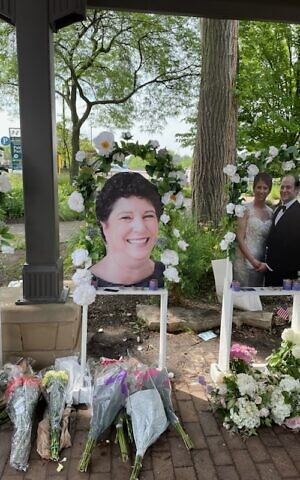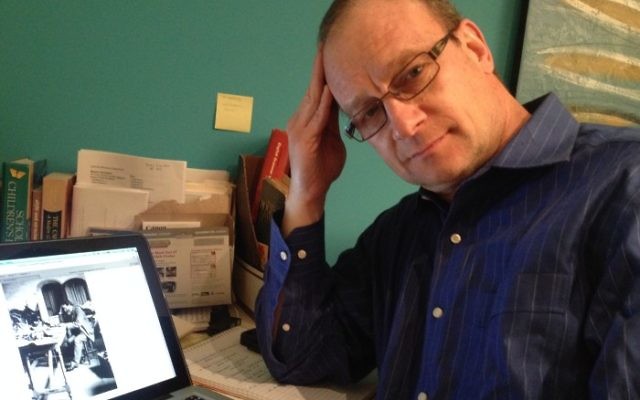Horror in a Place Once Called Home
Dave Schechter recalls growing up in Highland Park, Ill., the site of a mass shooting at a Fourth of July public gathering.
Dave Schechter is a veteran journalist whose career includes writing and producing reports from Israel and elsewhere in the Middle East.
This is Jewish life in America.
On Monday, my journalist daughter texted to make sure I knew about a gunman firing on the Fourth of July parade in Highland Park, Ill. Just as she did to alert us on Oct. 27, 2018, when a gunman massacred 11 worshippers at the Tree of Life synagogue in Pittsburgh.
I lived in Highland Park from ages 4 to 9, until we moved to Glencoe, one town to the south. I am familiar with the streets that formed the parade route, including Central Avenue, where most of the spectators congregated.
I went to nursery school at a Conservative congregation in Highland Park, before starting public school in kindergarten. After moving, we joined a Reform congregation in Glencoe. Years later, after leaving for another Reform congregation, my parents also held a membership in that Conservative shul.

After my daughter’s text, my first thought was to check on my mother and sister, who live in downtown Chicago. In good weather, they like to drive to the Chicago Botanic Garden, located on the road that divides Glencoe from Highland Park. It turned out that they had visited the garden the day before. My sister volunteers with the American Red Cross and was dispatched to Highland Park on the Fourth and on subsequent days.
My second thought was grounded in an awareness that Highland Park has a significant Jewish population; perhaps 30 percent, maybe more, of its 30,000 residents. This is a city where the Maxwell Street Klezmer Band takes part in the Fourth of July parade.
Prosecutors say that the 21-year-old man now charged with seven counts of first-degree murder has confessed to the shootings. On a downtown rooftop, police recovered 83 shell casings, three ammunition magazines and a legally-purchase semi-automatic rifle.

The Pittsburgh gunman announced his intention to kill Jews; the motivation for the Highland Park shootings is less clear. Michael Masters, CEO of the Secure Community Network, an initiative of the Jewish Federations of North America, told the Chicago Sun-Times that the available information did not support antisemitism as the motive.
Masters told the newspaper, “there are some indications he was ideating around the Fourth of July for some period of time, which would indicate this was not an attack on one particular community.” The Lake County Major Crimes Task Force spokesperson told reporters: “We have no information to suggest at this point it was racially motivated, motivated by religion, or any other protected status.”
In one sense, it does not matter whether the shooter targeted Jews. Even if the intention was to kill as many people as possible — regardless of their religion, race, ethnicity or other characteristics — Jews were killed and Jews were wounded. Incidents in recent years — Pittsburgh, Poway, Monsey, Jersey City, etc. — have conditioned the Jewish community to assume an antisemitic motive, particularly where there is a significant Jewish presence.
It was reported that in April the accused had entered the Chabad shul in downtown Highland Park and was watched carefully until he left. That same month, on Yom HaShoah/Holocaust Remembrance Day, antisemitic flyers turned up in driveways in Highland Park and other nearby suburbs. “To have this kind of garbage, disgusting statements thrown on peoples’ driveways — on today of all days — is particularly painful,” Highland Park’s mayor said.
For residents of this suburb along Lake Michigan, 27 miles north of Chicago, the date of July 4 now is attached not to a celebration, but to an act of terror. Healthcare consultant and journalist Michael Millenson, a friend of my late father, wrote in the Forward about how he and his wife escaped the gunfire. “We are grateful to be alive, but we are haunted forever by what we saw and what we heard,” Millenson said.
My third thought was prompted by comments on Twitter from Jewish journalists, academics, activists and professionals, who form what is referred to informally as #JTwitter.
This tragedy prompted a national exercise of “Jewish geography,” the game that ultimately confirms that there are fewer than six degrees of separation between any two Jews in this country. As if to prove the point, as the names of the dead became known, one was a woman a couple of my siblings had known decades ago, from the youth group at the Glencoe synagogue, where, as an adult, she was the events and b’nei mitzvah coordinator.
In the aftermath of the Tree of Life killings, I wrote about Jewish Atlantans with ties to Pittsburgh and the Squirrel Hill neighborhood. Numerous Jews I follow on social media mentioned ties to Highland Park. “Guess I shouldn’t be surprised at the number of us who lived in Highland Park at some point in our lives,” I posted on Twitter.
We all come from somewhere. When such horror is visited on a community we once called home, maybe we feel what we feel just a bit more acutely. Such is the case with Highland Park, a city I have not lived in for many years, but which still gives rise to countless childhood memories.
- From Where I Sit
- Opinion
- Highland Park
- Mass Shooting
- July 4
- Fourth of July
- NRA
- Guns
- Tree of Life
- Chicago Botanic Garden
- Glencoe
- Maxwell Street Klezmer Band
- American Red Cross
- Lake County Major Crimes Task Force
- Pittsburgh
- Poway
- Monsey
- Jersey City
- Chabad
- Antisemitism
- Yom HaShoah
- Holocaust Remembrance Day
- Lake Michigan
- Michael Millenson
- Squirrel Hill




comments